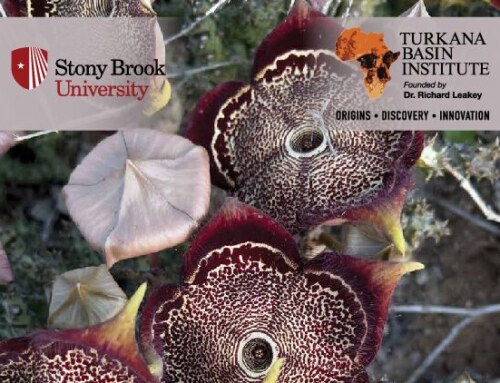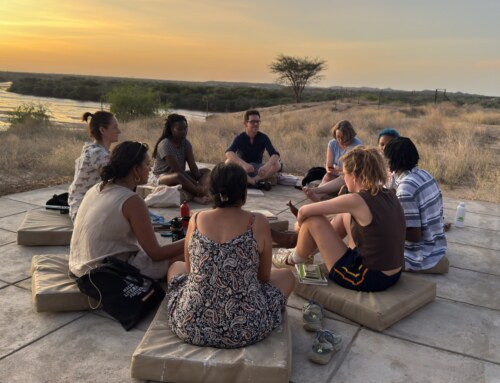Molecular studies in the late 1960s demonstrated that humans are closely related to chimpanzees and gorillas, and that all three of these great ape lineages shared a relatively recent origin on the African continent. Continued study and methodological advances since this time have revealed that humans and chimpanzees are each other’s closest living relatives and diverged (i.e., split from one another, going their separate evolutionary paths) around 7-10 million years ago (Ma). For those of us studying the paleontological record of human origins, these molecular data imply that if we’re on the hunt for fossils of the very earliest hominins—hominins being the scientific name for modern humans and the variety of extinct species more closely related to us than to chimpanzees—three important criteria need to be satisfied. First, we must carry out our fossil search in Africa. Chimpanzees and gorillas are both restricted to Africa today, suggesting that the hominin lineage most likely originated on the continent. Second, we need to focus on rocks that fall within the temporal window of human-chimpanzee divergence, ~ 7-10 Ma. Third, those ~ 7-10 Ma rocks need to be sedimentary in nature, as only sedimentary rocks regularly preserve fossil bone. Like a good detective story, once we’ve identified rocks in the right place, of the right age, and of the right type, we can begin our search for the earliest hominins. So where to?

Two researchers from the University of California Berkeley, Vincent Sarich and Allan Wilson, published their paper titled ‘Immunological Time Scale for Hominid Evolution’ in a 1967 issue of Science. Their time-scaled evolutionary tree, or phylogeny, showed that humans were closely related to the living African apes, and that humans (Homo), chimpanzees (Pan), and gorillas (Gorilla) shared a recent ancestry. Later work resolved that the human and chimpanzee lineages are most closely related to one another and that they last shared a common ancestry between 7-10 million years ago (Ma).
While the Turkana Basin has produced a huge amount of fossil evidence for human evolution, the critical period ~ 7-10 Ma when the hominin lineage originated is poorly represented in the region. The site of Lothagam, southwest of present-day Lake Turkana, is the notable exception. In the 1960s the archaeologist Lawrence H. Robbins first recognized Lothagam’s potential as an important paleontological locality, which inspired an initial fossil collecting expedition by Bryan Patterson and a team from Harvard University. Work at Lothagam continued into the 1970s, then directed mostly by a crew from Princeton University. Based mainly on the types of mammal taxa preserved, it was then estimated that the site dated to ~ 6 Ma. Later work by Meave Leakey and the Koobi Fora Research Project from 1990-1993 significantly expanded the fossil collection and provided a detailed stratigraphic framework showing that most of the mammal-bearing portions of the Lothagam sequence ranged in age from ~ 7.5-3.5 Ma. In 2003 an outstanding monograph, ‘Lothagam: The Dawn of Humanity in Eastern Africa’, was published by Columbia University Press detailing the finds from the 1960s-1990s. Despite an abundant mammal fauna, hominins were frustratingly rare. For hominins, Lothagam had only produced a fragmentary mandible and handful of teeth dated to ~ 5.5-3.5 Ma.
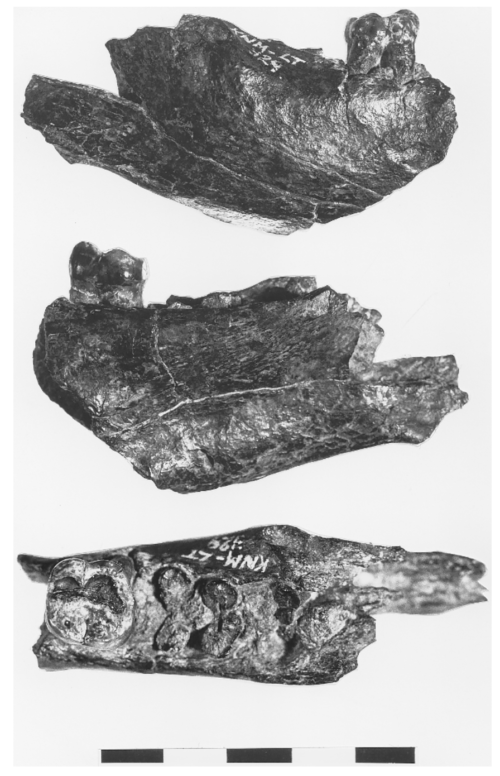
KNM-LT 329, the ‘Lothagam mandible’, discovered by Bryan Patterson’s Harvard expedition in the 1960s is dated to ~ 5-4.5 Ma. Despite being the most complete hominin remain from Lothagam, the fragmentary nature of this jaw has sparked decades of debate about its taxonomic identity and significance.
Since 1993—when the last major field work campaign at Lothagam was carried out—our knowledge of the earliest phases of human evolution has changed considerably. In 1993, the oldest named hominin taxon was Lucy’s species, Australopithecus afarensis, best known from 3-3.5 Ma deposits in Ethiopia and Tanzania, but this changed quickly. In 1994 the world was introduced to 4.4-Ma Ardipithecus ramidus and, in 1995, 4.2-Ma Australopithecus anamensis. Only a few years later, a series of papers announced the discovery of even older probable hominin taxa: ~ 5.6-5.8 Ma Ardipithecus kadabba from the Middle Awash of Ethiopia, ~ 6 Ma Orrorin tugenensis from the Tugen Hills in Kenya, and ~ 6-7 Ma Sahelanthropus tchadensis from Toros-Menalla in Chad. The hominin fossil record quickly filled up and began to approach the critical ~ 7-10 Ma window for the human-chimpanzee divergence indicated by molecules.
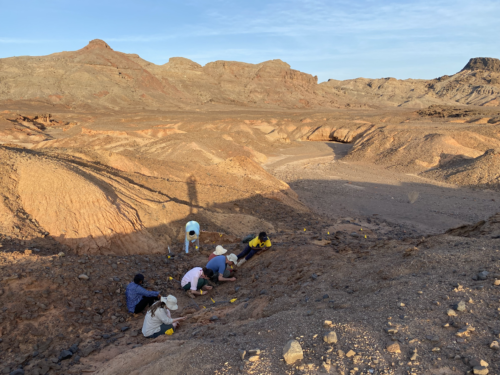
Lothagam’s Nawata Formation provides a record of early hominins and other mammals that lived alongside a large river system flowing through the southwestern Turkana Basin in the late Miocene and early Pliocene.
As new fossil finds pushed the paleontological evidence for hominin origins back in time and closer to the human-chimpanzee divergence, Lothagam stood as an interesting puzzle. The site had produced an abundant and well-preserved mammalian fauna going back to ~ 7.5 Ma, but very ancient hominin remains had not been found. My colleagues and I began to wonder if three decades of erosion might have replenished the outcrop surfaces with new fossils waiting to be collected. Potentially, those newly eroded fossils included early hominins. With this in mind, we established the Lothagam Research Project and, after a slight pandemic-related pause, just completed our first field season at the site in June 2022. Our expedition was very successful—we collected over two hundred mammal fossils and added a handful of new taxa to Lothagam’s species list. Primates of all kinds were abundant—we collected several nicely preserved fossils from Lothagam’s ‘Monkey Area’, as it was aptly named by the Koobi Fora Research Project team.
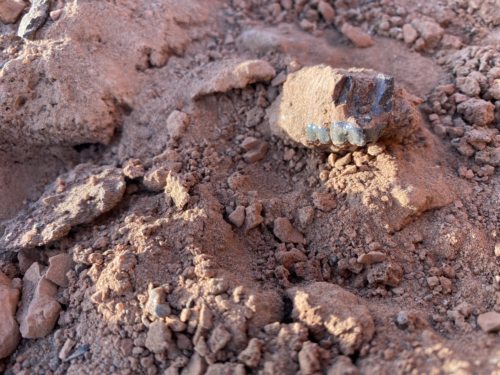
A nearly complete maxilla of an early papionin monkey (Parapapio lothagamensis) eroding out of the Nawata Formation sediments.
We’re looking forward to sharing more details about our new finds, and to our future field seasons at Lothagam… there is much to be discovered there! Indeed, on one of our first days in the field, we found a chip of calcite that the famed fossil hunter Kamoya Kimeu carved his name into nearly three decades ago… We’ll take that as a sign of good luck for our continued work at Lothagam… but that’s all for now!
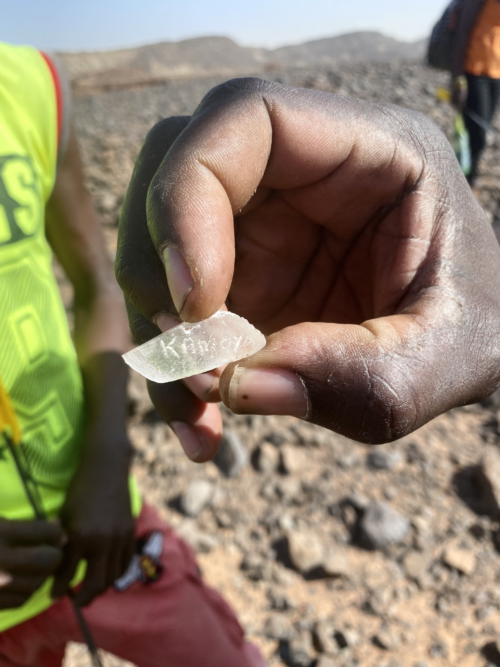
A calcite fragment from Lothagam engraved with the name ‘Kamoya’.
Authored by Dr. John Rowan.


